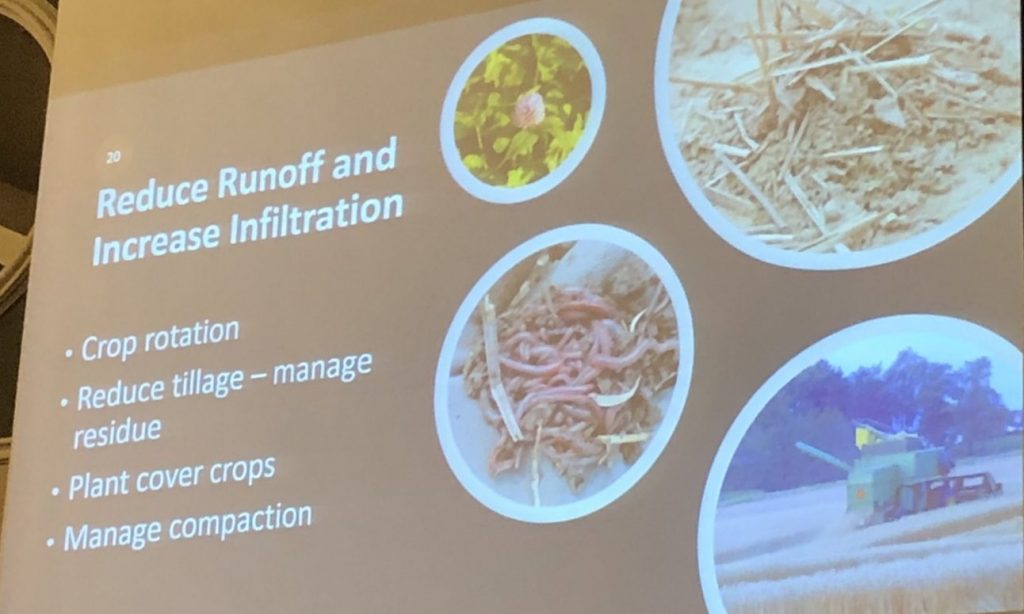
Features
Environment
Promoting infiltration over runoff for better drainage
Good infiltration means more water is held by the soil or the tile drainage instead of running off and causing erosion or nutrient loss.
February 3, 2020 By Stephanie Gordon
 Anne Verhallen presented on promoting good infiltration at the 2020 LICO conference.
Anne Verhallen presented on promoting good infiltration at the 2020 LICO conference. Good soil infiltration helps with the efficacy of tile drainage.
Anne Verhallen, soil management specialist with Ontario’s Ministry of Agriculture, Food and Rural Affairs (OMAFRA), presented on the topic at the Land Improvement Contractors of Ontario (LICO) conference held in London, Ont. from Jan. 21 to 23, 2020.
During the presentation, Verhallen used a rainfall simulator to show the difference between runoff and infiltration. The rainfall simulator mimicked the effects of rainfall on soil by spraying water over soil and setting up jars to catch the runoff. How much water/soil escaped and was captured by the jars would give an indication on how well the soils held onto water.
Check out the rainfall simulator. Where does your rain go? #cofs15 #OSCIA #OMAFRA #soilsinsight pic.twitter.com/pRChZkHUfL
Advertisement— Ontario Soil & Crop (@OntarioSoilCrop) September 15, 2015
Runoff or infiltration?
Verhallen breaks down the difference between the two. “Runoff is when we have rainfall and it impacts the soil and it doesn’t go in, it runs off,” Verhallen explains. “It can cause problems in that it will fill up our ditches, tends to cause more [soil] erosion, and things like that.”
Verhallen says that infiltration is what makes crop farmers happy. “It’s the water that recharges the soil profile,” Verhallen says. “It’s also the water that then gets handled, if there’s excess, by the tile drainage.”
What type of soils have good infiltration?
During LICO, Verhallen demonstrated the rainfall simulator using different types of soils. The soils ranged from soils that had short crop rotations to soils that had longer, diverse crop rotations with cover crops, to one example of soil from the bush (not cropland).
“Infiltration can really vary and so can runoff depending on the soil type,” Verhallen says. “Right off the bat, we have things like topography and texture.
“So with rolling landscapes we tend to get more runoff, it’s harder to get water to infiltrate. Soil types that are light, open and porous at the surface like sands and sandy loams tend to have more infiltration whereas clay soils tend to have more runoff.”
While landowners can’t change the texture and topography of their soils to a certain degree, they can change the management of their soils.
“If we want clay soils to take water in and infiltrate water into the soil, then we need to create an open porous surface,” Verhallen starts. She says there are several ways to create a more open porous surface and promote infiltration including:
- Leaving residue
- Reducing tillage
- Having a diverse crop rotation
- Growing cover crops
- Managing soil compaction
“We’ve found that anywhere we’ve got cover crops we’re going to have improved infiltration,” Verhallen says. “By using more diverse crops in our rotation we’re going to build a better soil structure. When we have a more stable soil structure and we get those heavy pounding rains, the soil will still say open . . . and that will allow the water to come in.”
Why is good infiltration good for tile drainage?
“Good infiltration works hand in hand with tile drainage to make sure that we have a soil profile that is holding as much water as possible for the crop – that keeps the farmer happy – but also [soil that] has access so that any excess will go off through the tile,” Verhallen says.
“Good infiltration works hand in hand with tile drainage to make sure that we have a soil profile that is holding as much water as possible.”
“That manages water a little bit better and we have options for management then. If we don’t get the water in [the soil] then we are more prone to runoff and anytime we have runoff we have more erosion and we have loss of nutrients and soil and that costs everybody money.”
Watch the full interview below:
At #LICO20 we asked @Anne_Verhallen about:
– the difference between runoff and infiltration?
– which soils have good infiltration?
and most importantly, why is good infiltration good for tile drainage? #tile20 #ontag pic.twitter.com/Z9jNioSuJT— Drainage Contractor (@DrainageContMag) January 24, 2020
Print this page